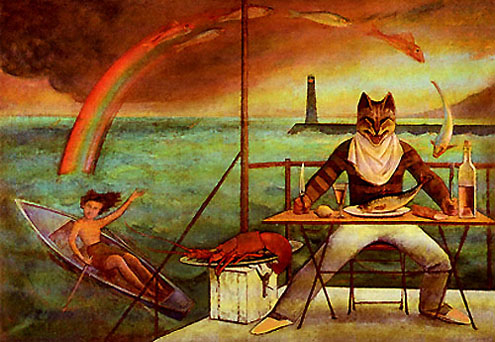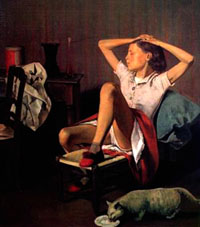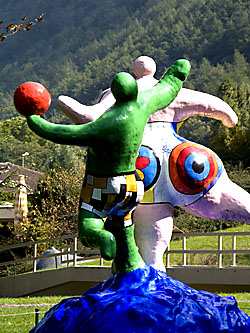
Balthus at Martigny
By William Dowell, October 2008
It is impossible to go to Martigny these days and not be aware of Balthus. The artist, who died in 2001, has his name plastered everywhere, on the town hall, on the windows of cafes, the walls of houses and even the exits on the autoroute. This is the hundredth anniversary of Balthus’ birth, and the Foundation Pierre Gianadda in Martigny is hosting the world’s only definitive retrospective of his work. Jean Claire, former director of the Picasso Museum, and author of the only catalogue raisonné on Balthus work, co-curated the exhibition, and the quality approaches the level one would expect at Paris’ Pompidou or New York’s MoMa. The paintings have been drawn from collections around the world, and for anyone interested in art, this is a unique opportunity not to be missed.
 Therese dreaming Therese dreaming |
As with Lewis Caroll, who created Alice in Wonderland, Balthus’ fascination with young girls, who often seemed to be experiencing erotic fantasies, flirted with scandal and raised suspicions about his motives. His portrait of “Thérése dreams,” used for the exhibition’s poster, demonstrates the point. Balthus always claimed that there was nothing erotic in his paintings, or rather that the eroticism was in the eye of the beholder. What he was really after, he insisted, was the mysterious, and that led him to focus on three areas. Mirrors fascinated him. He loved cats, and he was endlessly intrigued by the angelic quality of girls. Despite the scandal, he was considered by some to be one of the great realist painters of the 20th century, in the line of Poussin. Ironically, it is often his less realistic paintings, which are the most appealing. The exhibition at the Pierre Gianadda center shows that there is considerably more to Balthus than is generally realized. Some of the paintings are masterpieces of geometric construction. His pencil sketches are exquisite. His portrait of New York art dealer, Pierre Matisse, son of the painter, is striking.
Beyond that, the exhibition reveals Balthus as an extraordinary personality with an even more extraordinary history. His mother was the lover of the German poet Rilke, and for a while, Rilke served as an adopted father. Andre Malraux greatly admired Balthus, and as culture minister, sent him on a number of missions. Giacometti was a close friend, as was Picasso, who owned several of his paintings.
Balthus liked to think of himself as the “King of the Cats,” and after an impressive lunch at “La Mediterranée,” a restaurant at the Odeon in Paris, Balthus painted the Cat of the Mediterranean. The surrealistic painting shows a mischievous cat, with a knife and fork at a table by the seaside. A rainbow arcs on to his plate, gradually morphing into a succession of fish offered for the cat’s dinner. There is little doubt that the cat is intended to portray Balthus.
Even if the Balthus exhibit were not so exceptional, the Pierre Gianadda Foundation merits a trip to Martigny, roughly a 90-minute drive from Geneva. The foundation hosts a magnificent sculpture garden with works ranging from the primary color, epoxy statues of Nikki de St. Phael to Francois-Xavier Lalanne and his fiber-concrete sheep. A completely different exhibit includes a collection of machines richly crafted from the designs of Léonardo da Vinci. In the basement, there is a superb collection of antique cars that qualify as sculpture in their own right.
 Niki de Saint Phalle Niki de Saint Phalle |
Léonard Gianadda, a local builder who had already constructed 1,000 apartments in Martigny, inaugurated the foundation in 1978. He was working on a new development when he unearthed an ancient Roman ruin. While he was trying to decide what to do with the unexpected discovery, his brother, Pierre, who was 38 at the time, was killed in a freak accident. Pierre had been collecting specimens in Egypt with the head of Lausanne’s vivarium. On the return flight, their light plane had to make an emergency landing in southern Italy. The plane crashed into some branches of an olive tree and burst into flame. Pierre escaped with three other passengers, but then went back into the plane in a heroic attempt to rescue the pilot and another passenger. After suffering terrible burns himself, Pierre died a week later. Shattered by the loss, Léonard decided to create the foundation in memory of his brother. The high quality of the exhibitions has not only put Martigny on the map, but also earned Leonardo Gianadda admission to the Academie Francaise. For the rest of us, it is an experience not to be missed.
For more information go on line at http://www.gianadda.ch/